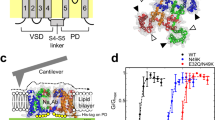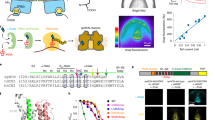Abstract
In voltage-gated sodium, potassium and calcium channels, the functions of ion conduction and voltage sensing are performed by two distinct structural units: the pore domain and the voltage-sensing domain (VSD). In the hydrogen voltage-gated channel 1 (Hv1), the VSD, unusually, performs both functions. Hv1 was recently found to dimerize and to form channels made of two pores. However, the channels were also found to function when dimerization was prevented, raising a question about the functional role of dimerization. Here we show that the two subunits of the human Hv1 dimer influence one another during gating, with positive cooperativity shaping the response to voltage of the two pores. We also find that the two voltage sensors undergo conformational changes that precede pore opening and that these conformational changes are allosterically coupled between the two subunits. Our results point to an important role for dimerization in the modulation of Hv1 activity.
This is a preview of subscription content, access via your institution
Access options
Subscribe to this journal
Receive 12 print issues and online access
$189.00 per year
only $15.75 per issue
Buy this article
- Purchase on Springer Link
- Instant access to full article PDF
Prices may be subject to local taxes which are calculated during checkout






Similar content being viewed by others
References
Decoursey, T.E. Voltage-gated proton channels and other proton transfer pathways. Physiol. Rev. 83, 475–579 (2003).
Henderson, L.M., Chappell, J.B. & Jones, O.T. The superoxide-generating NADPH oxidase of human neutrophils is electrogenic and associated with an H+ channel. Biochem. J. 246, 325–329 (1987).
DeCoursey, T.E., Morgan, D. & Cherny, V.V. The voltage dependence of NADPH oxidase reveals why phagocytes need proton channels. Nature 422, 531–534 (2003).
Ramsey, I.S., Ruchti, E., Kaczmarek, J.S. & Clapham, D.E. Hv1 proton channels are required for high-level NADPH oxidase-dependent superoxide production during the phagocyte respiratory burst. Proc. Natl. Acad. Sci. USA 106, 7642–7647 (2009).
Ramsey, I.S., Moran, M.M., Chong, J.A. & Clapham, D.E. A voltage-gated proton-selective channel lacking the pore domain. Nature 440, 1213–1216 (2006).
Sasaki, M., Takagi, M. & Okamura, Y. A voltage sensor-domain protein is a voltage-gated proton channel. Science 312, 589–592 (2006).
Tombola, F., Ulbrich, M.H. & Isacoff, E.Y. The voltage-gated proton channel Hv1 has two pores, each controlled by one voltage sensor. Neuron 58, 546–556 (2008).
Koch, H.P. et al. Multimeric nature of voltage-gated proton channels. Proc. Natl. Acad. Sci. USA 105, 9111–9116 (2008).
Lee, S.Y., Letts, J.A. & Mackinnon, R. Dimeric subunit stoichiometry of the human voltage-dependent proton channel Hv1. Proc. Natl. Acad. Sci. USA 105, 7692–7695 (2008).
Long, S.B., Campbell, E.B. & Mackinnon, R. Crystal structure of a mammalian voltage-dependent Shaker family K+ channel. Science 309, 897–903 (2005).
Tombola, F., Pathak, M.M. & Isacoff, E.Y. How does voltage open an ion channel? Annu. Rev. Cell Dev. Biol. 22, 23–52 (2006).
Zagotta, W.N., Hoshi, T. & Aldrich, R.W. Shaker potassium channel gating. III: Evaluation of kinetic models for activation. J. Gen. Physiol. 103, 321–362 (1994).
Schoppa, N.E. & Sigworth, F.J. Activation of Shaker potassium channels. III. An activation gating model for wild-type and V2 mutant channels. J. Gen. Physiol. 111, 313–342 (1998).
Ledwell, J.L. & Aldrich, R.W. Mutations in the S4 region isolate the final voltage-dependent cooperative step in potassium channel activation. J. Gen. Physiol. 113, 389–414 (1999).
Pathak, M., Kurtz, L., Tombola, F. & Isacoff, E. The cooperative voltage sensor motion that gates a potassium channel. J. Gen. Physiol. 125, 57–69 (2005).
Yifrach, O. & MacKinnon, R. Energetics of pore opening in a voltage-gated K+ channel. Cell 111, 231–239 (2002).
Ulbrich, M.H. & Isacoff, E.Y. Subunit counting in membrane-bound proteins. Nat. Methods 4, 319–321 (2007).
DeCoursey, T.E. & Cherny, V.V. Pharmacology of voltage-gated proton channels. Curr. Pharm. Des. 13, 2400–2420 (2007).
Murata, Y., Iwasaki, H., Sasaki, M., Inaba, K. & Okamura, Y. Phosphoinositide phosphatase activity coupled to an intrinsic voltage sensor. Nature 435, 1239–1243 (2005).
Kohout, S.C., Ulbrich, M.H., Bell, S.C. & Isacoff, E.Y. Subunit organization and functional transitions in Ci-VSP. Nat. Struct. Mol. Biol. 15, 106–108 (2008).
Koshland, D.E. Jr., Némethy, G. & Filmer, D. Comparison of experimental binding data and theoretical models in proteins containing subunits. Biochemistry 5, 365–385 (1966).
Mannuzzu, L.M., Moronne, M.M. & Isacoff, E.Y. Direct physical measure of conformational rearrangement underlying potassium channel gating. Science 271, 213–216 (1996).
Cherny, V.V., Markin, V.S. & DeCoursey, T.E. The voltage-activated hydrogen ion conductance in rat alveolar epithelial cells is determined by the pH gradient. J. Gen. Physiol. 105, 861–896 (1995).
Choe, H., Zhou, H., Palmer, L.G. & Sackin, H. A conserved cytoplasmic region of ROMK modulates pH sensitivity, conductance, and gating. Am. J. Physiol. 273, F516–F529 (1997).
Gagnon, D.G. & Bezanilla, F. A single charged voltage sensor is capable of gating the Shaker K+ channel. J. Gen. Physiol. 133, 467–483 (2009).
Mannuzzu, L.M. & Isacoff, E.Y. Independence and cooperativity in rearrangements of a potassium channel voltage sensor revealed by single subunit fluorescence. J. Gen. Physiol. 115, 257–268 (2000).
Schoppa, N.E., McCormack, K., Tanouye, M.A. & Sigworth, F.J. The size of gating charge in wild-type and mutant Shaker potassium channels. Science 255, 1712–1715 (1992).
Noceti, F. et al. Effective gating charges per channel in voltage-dependent K+ and Ca2+ channels. J. Gen. Physiol. 108, 143–155 (1996).
Hirschberg, B., Rovner, A., Lieberman, M. & Patlak, J. Transfer of twelve charges is needed to open skeletal muscle Na+ channels. J. Gen. Physiol. 106, 1053–1068 (1995).
Aggarwal, S.K. & MacKinnon, R. Contribution of the S4 segment to gating charge in the Shaker K+ channel. Neuron 16, 1169–1177 (1996).
Seoh, S.A., Sigg, D., Papazian, D.M. & Bezanilla, F. Voltage-sensing residues in the S2 and S4 segments of the Shaker K+ channel. Neuron 16, 1159–1167 (1996).
Papazian, D.M. et al. Electrostatic interactions of S4 voltage sensor in Shaker K+ channel. Neuron 14, 1293–1301 (1995).
Morgan, D. & DeCoursey, T.E. Diversity of voltage gated proton channels. Front. Biosci. 8, s1266–s1279 (2003).
Thomas, R.C. & Meech, R.W. Hydrogen ion currents and intracellular pH in depolarized voltage-clamped snail neurones. Nature 299, 826–828 (1982).
Sonnleitner, A., Mannuzzu, L.M., Terakawa, S. & Isacoff, E.Y. Structural rearrangements in single ion channels detected optically in living cells. Proc. Natl. Acad. Sci. USA 99, 12759–12764 (2002).
Larsson, H.P., Baker, O.S., Dhillon, D.S. & Isacoff, E.Y. Transmembrane movement of the shaker K+ channel S4. Neuron 16, 387–397 (1996).
Musset, B. et al. Detailed comparison of expressed and native voltage-gated proton channel currents. J. Physiol. (Lond.) 586, 2477–2486 (2008).
Acknowledgements
We are grateful to S. Wiese and W. McFadden for valuable technical assistance. We thank D.E. Clapham (Children's Hospital Boston) for the cDNA of the human Hv1 channel and Y. Okamura (Okazaki Center for Integrative Biosciences) for the cDNA of Ci-VSP. We thank J.E. Hall and S.H. White for helpful discussion. This work was supported by the US National Institutes of Health (grant R01NS035549 to E.Y.I.), by the American Heart Association WSA (grant 09BGIA2160044 to F.T.) and by a postdoctoral fellowship from the American Heart Association to M.H.U.
Author information
Authors and Affiliations
Corresponding author
Supplementary information
Supplementary Text and Figures
Supplementary Methods, including Supplementary Figs. 1–8 (PDF 1336 kb)
Rights and permissions
About this article
Cite this article
Tombola, F., Ulbrich, M., Kohout, S. et al. The opening of the two pores of the Hv1 voltage-gated proton channel is tuned by cooperativity. Nat Struct Mol Biol 17, 44–50 (2010). https://doi.org/10.1038/nsmb.1738
Received:
Accepted:
Published:
Issue Date:
DOI: https://doi.org/10.1038/nsmb.1738
This article is cited by
-
Mechanosensitive aquaporins
Biophysical Reviews (2023)
-
Multiple mechanisms contribute to fluorometry signals from the voltage-gated proton channel
Communications Biology (2022)
-
Voltage-gated proton channels from fungi highlight role of peripheral regions in channel activation
Communications Biology (2021)
-
Voltage and pH difference across the membrane control the S4 voltage-sensor motion of the Hv1 proton channel
Scientific Reports (2020)
-
Probing the gating mechanism of the mechanosensitive channel Piezo1 with the small molecule Yoda1
Nature Communications (2018)



